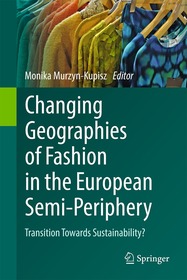
Changing Geographies of Fashion in the European Semi-Periphery
Transition Towards Sustainability?
- Publisher's listprice EUR 171.19
-
71 001 Ft (67 620 Ft + 5% VAT)
The price is estimated because at the time of ordering we do not know what conversion rates will apply to HUF / product currency when the book arrives. In case HUF is weaker, the price increases slightly, in case HUF is stronger, the price goes lower slightly.
- Discount 20% (cc. 14 200 Ft off)
- Discounted price 56 801 Ft (54 096 Ft + 5% VAT)
Subcribe now and take benefit of a favourable price.
Subscribe
71 001 Ft

Availability
Not yet published.
Why don't you give exact delivery time?
Delivery time is estimated on our previous experiences. We give estimations only, because we order from outside Hungary, and the delivery time mainly depends on how quickly the publisher supplies the book. Faster or slower deliveries both happen, but we do our best to supply as quickly as possible.
Product details:
- Publisher Springer Nature Switzerland
- Date of Publication 4 November 2025
- Number of Volumes 1 pieces, Book
- ISBN 9783031892530
- Binding Hardback
- No. of pages484 pages
- Size 235x155 mm
- Language English
- Illustrations XVII, 484 p. 116 illus., 89 illus. in color. 700
Categories
Long description:
"
Sustainability in fashion production and consumption is considered a major contemporary challenge and at the same time a visible trend in the fashion market. Despite a growing body of academic literature on the topic, detailed analyses have so far mainly pertained to only a selected dimension of the fashion market (design, production, retail or consumption). They have more often explored major fashion centres, brands and firms rather than independent designers, SMEs or independent fashion events and other alternative consumption means and spaces or less obvious intermediaries in the fashion market. Although the issue of sustainable fashion has been noticed in the academic discourse in Poland, it is yet to be examined bringing together the production and consumption side of the issue. Nor has the spatial dimension of fashion market transformation in Poland been analysed in detail.
Taking a geographic perspective, this book fills this research gap by presenting a holistic approach to the fashion market – including design, production and consumption of fashion – considering the social, cultural and spatial dimensions of the matter and diverse stakeholders who participate in it. Providing a comprehensive analysis of long-term changes in the Polish fashion market, the book addresses several interesting issues. These include the extent to which the sustainable reorientation of the fashion market accompanies the broader processes of adaptation, restructuring and upgrading of the textile and clothing sector; how it fits into the broader logic of culturalisation of clothing production and commercialisation of design as an applied artistic genre and a part of the creative sector; and to what extent it is connected with new, alternative consumption patterns with respect to channels, places and spaces of clothing purchases and (re)use.
The main premise of the book is that although it is still a relatively small part of the fashion market in Poland, sustainable fashion design, production and consumption is an increasingly important phenomenon, with significant social, economic and spatial implications. The book therefore argues that sustainable design and production constitute a promising opportunity for adaptation, restructuring and upgrading of the textile and clothing sector in the European semi-periphery. Using the metaphor of the fashion ecosystem, it also illustrates how sustainable fashion practices contribute to the creation of new links and networks within the fashion industry, alongside a more fragmented domestic production structure.
" MoreTable of Contents:
Chapter 1. Geographies of fashion: research topics, issues and discourses.- Chapter 2. The changing nature and geography of contemporary textile and clothing production in Poland: beyond shrinking.- Chapter 3. Geography of fashion design education and the involvement of Polish educational institutions in the sustainability discourse.- Chapter 4. Large and medium size Polish clothing and apparel firms and their strategies in the context of global (sustainability) trends in the fashion market.- Chapter 5. Entrepreneurial strategies of independent fashion designers and small fashion producers in Poland: their links with the sustainability discourse and spatial ramifications.- Chapter 6. Independent fashion fairs in Poland and their spatial contexts.- Chapter 7. Polish museums as important emergent non-commercial stakeholders in the fashion ecosystem.- Chapter 8. Fashion consumers and their consumption patters as an opportunity or a major challenge to fashion sustainability in the Polish context?.- Chapter 9. Places, spaces and stakeholders in the fashion market in two major Polish cities. Taking a closer look at the fashion ecosystem on the local level.- Chapter 10. Conclusions. The importance of different spatial scales and participants in the fashion ecosystem for sustainable changes in the production and consumption of fashion in Poland.
More



